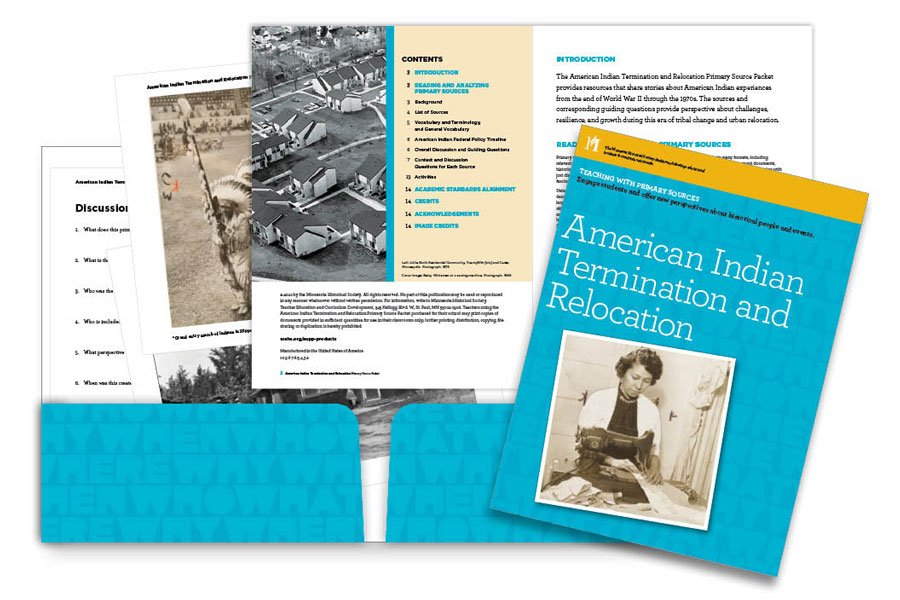Primary Source Packet: American Indian Termination and Relocation

Use primary sources in your classroom to analyze American Indian experiences during mid-century tribal change and relocation.
Laws enacted throughout the 1950s and 1960s encouraged Native people to assimilate in European American society and ended tribal sovereignty and trusteeship of reservation land. This packet shares stories about Native American experiences in the mid-20th-century and provides perspective about challenges, resilience, and growth during this era of tribal change and urban relocation.
Cost: $20 ORDER
Contents
- 16 primary sources including images, oral histories, artwork, and government documents.
- Discussion questions, context, guiding questions for each source.
Sources included:
- White Earth Ojibway residence. Photograph. 1946.
- Bureau of Indian Affairs memo. “Proposed Terminal Legislation for Indians of Southern Minnesota.” January 19, 1955.
- “She Left Reservation, But What of Future?: Indian comes to city for ‘opportunity’.” Minneapolis Sunday Tribune. May 6, 1956.
- “Indians Get Vocational Training Aid.” Bemidji Daily Pioneer. October 11, 1957.
- “Reservation Life and Job Indian Choice.” Bemidji Daily Pioneer. October 25, 1957.
- Ka-ka-gesick, Ojibway Medicine Man, being interviewed by Robert C. Wheeler of the Minnesota Historical Society. Photograph. 1963.
- “Chippewa Dancer.” Mixed media artwork by Patrick DesJarlait, 1964.
- “Sioux return to the land: City doesn’t satisfy Prior Lake band.” The Minneapolis Star. December 8, 1969.
- United States Census, 1970. Low-income Neighborhoods.
- United States Census, 1970. American Indian population by county.
- Grand entry march of Indians in Hippodrome at Minnesota State Fairgrounds. Photograph. October 22, 1972.
- Little Earth Residential Community, Minneapolis. Photograph. 1973.
- Shelley McIntire, Grand Portage Ojibwe photographer. Photograph. 1973.
- Oral History. Doug Sam. Recorded August 7, 1992.
- Oral History. Joseph Nayquonabe. Recorded August 25, 1992.
- Oral History. Ernest and Vernell Wabasha. Recorded July 11, 2006.


“Chippewa Dancer.” Mixed media artwork by Patrick DesJarlait, 1964.

Ka-ka-gesick, Ojibway Medicine Man, being interviewed by Robert C. Wheeler of the Minnesota Historical Society. Photograph. 1963.

“Indians Get Vocational Training Aid.” Bemidji Daily Pioneer. October 11, 1957.
Academic standards alignment
The American Indian Termination and Relocation Primary Source Packet is designed to engage your students and enrich their ability to read and analyze primary sources. Incorporating these sources, or adapting the questions and activities for other sources, into your teaching will help meet your curricular objectives and academic standards, whether they are content or skills related.
We have aligned this packet with state and national standards and benchmarks for grades 6–12. The link below outlines the standards alignment for this packet.
Academic Standards Connections
Related resources
- Minnesota Historical Society Oral Histories
- Native Voices: Native People’s Concept of Health and Wellness (The National Library of Medicine)
- Seven Council Fires
- Wabasha, Ernest Reginald (1929-2013) (MNopedia)
- 1970 Census of Population. Supplementary Reports, No. 87: Low-Income Neighborhoods, Minneapolis and St. Paul.
- 1970 Census of Population. Supplementary Reports, No. 104: Race of the Population by County.
- Sasha M. Suarez. Gakaabikaang: White Earth Ojibwe Women and the Creation of Indian Minneapolis in the Twentieth Century. (Dissertation, University of Minnesota, 2021).
Dakota language resources
- Beginning Dakota, MNHS
- Dakota language, Native American Community Board